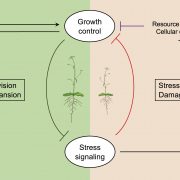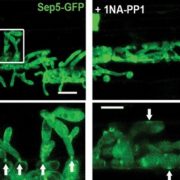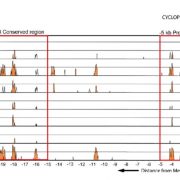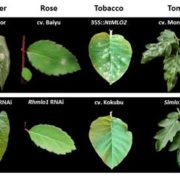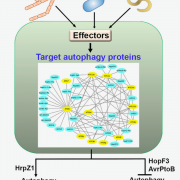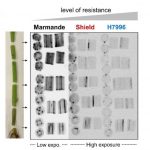Pathogenic bacteria target plant plasmodesmata to colonize and invade surrounding tissues (Plant Cell)
 Plasmodesmata are regulated channels that connect adjacent cells, allowing movement of metabolites, RNA, proteins, and pathogens. Plants close their plasmodesmata as part of their immune response, but this closure can be interfered with by pathogens. Aung et al. examined the repertoire of effector proteins produced by the plant pathogen Pseudomonas syringae pv. tomato (Pst) DC3000 and found that one of these, HopO1-1, localizes to the plasmodesmata. When HopO1-1 is deleted or compromised, the bacteria are severely compromised in virulence, and movement of fluorescent proteins through the plasmodemata is also diminished as compared to in the presence of the wild-type HopO1-1. PD-located receptor-like proteins (PDLPs) are known to regulate callose deposition at the plasmodesmata, which affects their permeability. The authors found that HopO1-1 interacts with two members of this family, PDLP 5 and PDLP7 and affects their stability, potentially through ribosylation. Knocking out these genes makes plants more susceptible to bacteria, consistent with a model in which the bacterial effector HopO1-1 enhances its virulence through targeting these proteins. (Summary by Mary Williams) Plant Cell 10.1105/tpc.19.00707
Plasmodesmata are regulated channels that connect adjacent cells, allowing movement of metabolites, RNA, proteins, and pathogens. Plants close their plasmodesmata as part of their immune response, but this closure can be interfered with by pathogens. Aung et al. examined the repertoire of effector proteins produced by the plant pathogen Pseudomonas syringae pv. tomato (Pst) DC3000 and found that one of these, HopO1-1, localizes to the plasmodesmata. When HopO1-1 is deleted or compromised, the bacteria are severely compromised in virulence, and movement of fluorescent proteins through the plasmodemata is also diminished as compared to in the presence of the wild-type HopO1-1. PD-located receptor-like proteins (PDLPs) are known to regulate callose deposition at the plasmodesmata, which affects their permeability. The authors found that HopO1-1 interacts with two members of this family, PDLP 5 and PDLP7 and affects their stability, potentially through ribosylation. Knocking out these genes makes plants more susceptible to bacteria, consistent with a model in which the bacterial effector HopO1-1 enhances its virulence through targeting these proteins. (Summary by Mary Williams) Plant Cell 10.1105/tpc.19.00707


